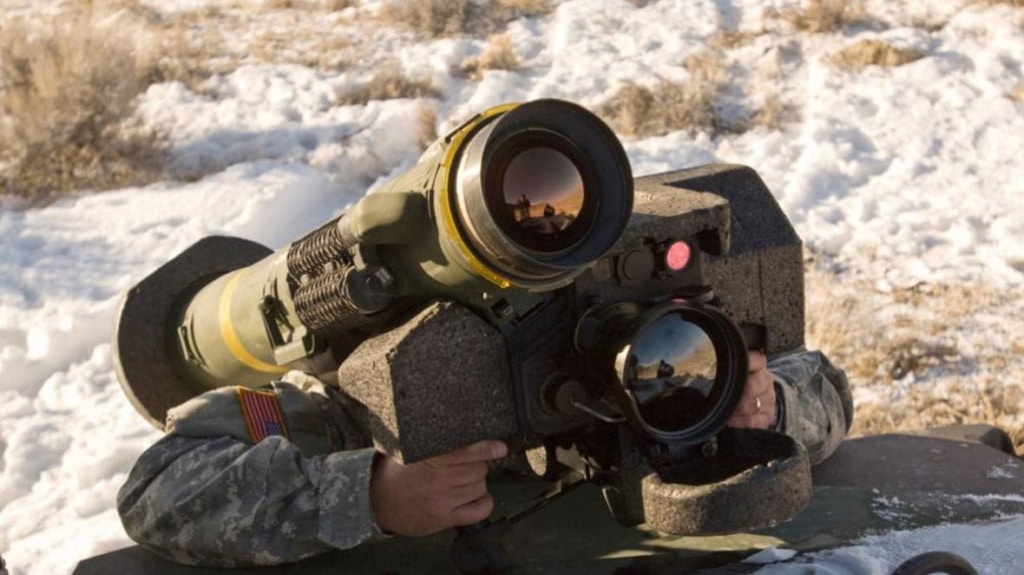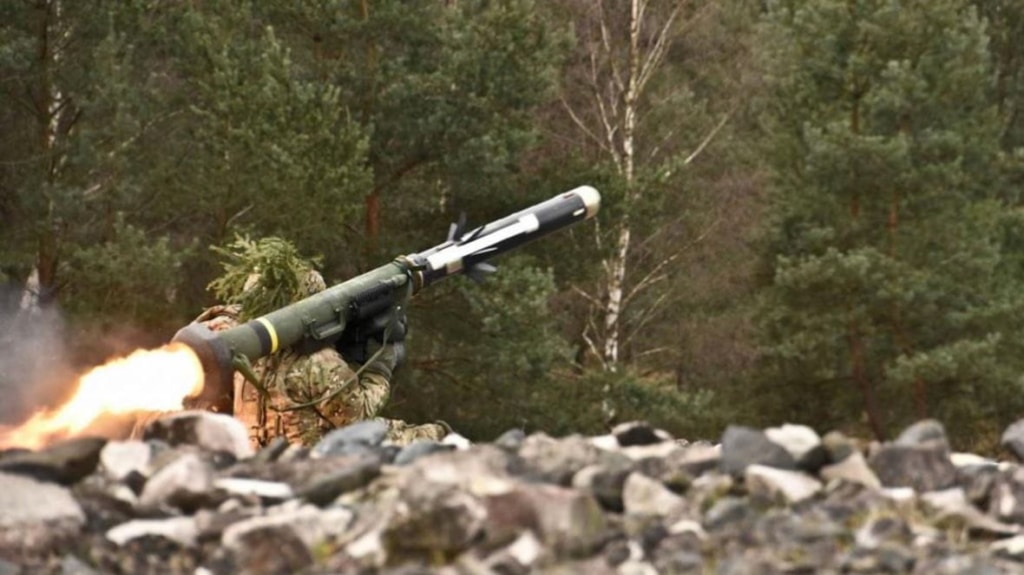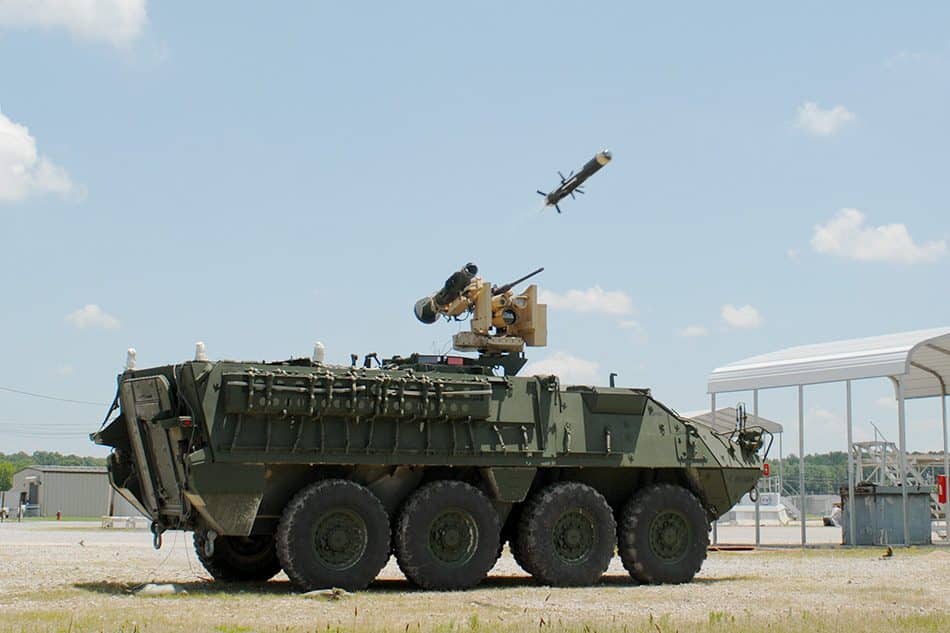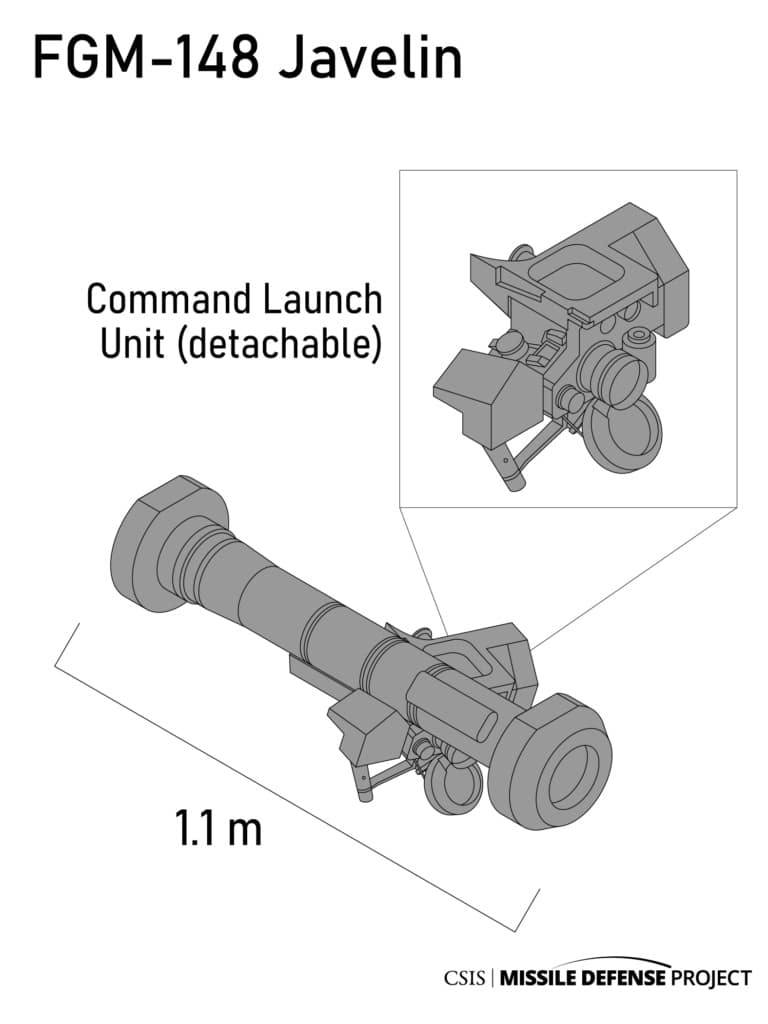The FGM-148 Javelin is a man-portable, “fire-and-forget” antitank guided missile (ATGM) system with an effective range of 2.5 km. It was designed to defeat heavily armored vehicles such as main battle tanks and lighter-skinned military vehicles. The weapon also has capability against other target types like fortifications, bunkers, and helicopters. It first entered service with the U.S. military in 1996. The Ukrainian military has used Javelin missiles extensively in combat during the 2022 Russian invasion of Ukraine, where the missile has shown to be highly effective against Russian main battle tanks and other armored vehicles.
FGM-148 Javelin at a Glance:
- Originated from
- United States
- Class
- Antitank Guided Missile (ATGM)
- Basing
- Portable, shoulder-fired
- Length
- 1.2 m
- Diameter
- 127 mm
- Launch weight
- 22.1 kg
- Payload
- 8.4 kg tandem-charge, high-explosive antitank (HEAT) warhead
- Propulsion
- Initial soft launch, with solid-propellant for flight motor
- Range
- 2.5 km (4.5 with Lightweight CLU)
- Speed
- 140 m/s
- Status
- Operational
- In service
- 1996-present
- Possessed by
- Australia, Bahrain, Czech Republic, Estonia, France, Georgia, Indonesia, Ireland, Jordan, Lithuania, New Zealand, Norway, Oman, Poland, Qatar, Saudi Arabia, Taiwan, Ukraine, United Arab Emirates, United Kingdom, United States



Javelin Development
The FGM-148 Javelin traces its roots back to the Defense Advanced Research Project Agency’s 1970s era “Tank Breaker” program put in place to replace the M47 Dragon, which had faced significant reliability and performance shortcomings since it had entered service in 1973.1 Drawing from system concepts developed for Tank-Breaker, the Army established the “Advanced Anti-Tank Weapon System-Medium” (AAWS-M) program in 1984 with the aim to replace the M47.2
In 1986, the Office of the Secretary of Defense approved the joint requirements for the AAWS-M, greenlighting the program to proceed with demonstration and validation. In 1989, the Pentagon awarded a full-scale development contract. Sometime after, the AAWS-M received the designation “Javelin,” and the AAWS-M Project Office was officially renamed the Javelin Program Office fiscal year 1991.3 Today, the program is officially designated the Javelin Close Combat Missile System – Medium and is manufactured jointly by Raytheon and Lockheed Martin through the Javelin Joint Venture (JJV).
In March 1993, the Javelin completed its first human-fired test launch, and over the course of the year it underwent Soldier and Marine portability and live-fire testing at Aberdeen Proving Grounds.4 The system completed initial operational testing and evaluation (IOT&E) in December 1993 and entered low-rate initial production the following year.5 The Javelin underwent limited user trials and initial and initial fielding with the U.S. Army in 1996. The first unit to receive the FGM-148 was the 3rd Battalion of the 75th Ranger Regiment at Fort Benning.6
In May 1997, the DOD approved the FGM-148 for full-rate production.7 Early modifications such as the Enhanced Producibility Program (EPP) and the Joint Enhanced Tandem Integration (JETI) led to two variants, designated the FGM-148B and FGM-148C.8 In 2006, the Army introduced a “Block 1” variant that included upgrades to the missile and the Command Launch Unit (CLU).9
Around 2013-14, the U.S. Army began a new endeavor to modernize the FGM-148 improve performance and reduce costs. The Army has since pursued four lines of effort: three enhancements to the Javelin missiles (referred to as Spirals 1, 2, and 3), and the development of a lightweight CLU. Spiral 1’s production designation is the FGM-148E, Spiral 2 became the FGM-148F, and Spiral 3 is designated the FGM-148G.10
Javelin Variants
- FGM-148A
The A-model was the original low-rate initial production model introduced in 1996. - FGM-148B
The B-model was likely the Enhanced Producibility Program (EPP) design introduced before the Javelin’s Milestone III. - FGM-148C
The C-model was introduced in 1999. The C-model likely includes the Javelin Enhanced Tandem Integration (JETI) modification, which was introduced during the missile’s third year of full rate production.11 Another DOD report also says FGM-148C features “enhancements that alter the missile dome.”12 - FGM-148D (Export Variant)
The D-model is an export variant designed for non-U.S. operators. - “Block 1”
The Block 1 entered production in 2006, with the missile boasting increased lethality and a shorter time of flight than previous variants. The upgraded Block 1 CLU featured increased I.D. range and surveillance time compared to the original CLU.13 - FGM-148E
The E-model is the result of the Spiral 1 Javelin enhancements which got underway around 2013-14, which included improved electronics in the missile control actuator section to decrease weight and cost. The FGM-148E entered produced in FY 2017.14 - FGM-148F
The F-model features a multi-purpose warhead (MPWH) to provide improved performance against “soft targets” like covered personnel, buildings, and light-armored vehicles. It also includes an updated command launch unit that weighs less and features an improved target tracker. The United States finalized a production contract for 2,100 F-Model missiles in January 2019. The first production line F-model missile was completed in May 2020.15 - FGM-148G
The G-model features an improved missile seeker that does not require cooling. This lowers missile deployment to launch times and provides operators more potential shots against targets of opportunity. The G-model also features a new launch tube assembly and battery unit.
Specifications
The Javelin measures roughly 1.2 m in length, 127 mm in diameter, and weighs 22.1 kg, with some minor differences depending on the variant. The missile carries a single 8.4 kg tandem-charge, high-explosive antitank (HEAT) warhead. It has a qualified maximum range of 2,500, though the U.S. notes that it has “demonstrated performance to 4,000 meters in most operational conditions.”16
It flies at around 140 m/s and reaches max altitudes of 150 m and 50 m while in top attack and direct attack modes, respectively. While the Javelin’s penetration capabilities are classified, U.S. military training documents note the Javelin “penetrates all known armor, well in excess of 30 inches [762 mm] of rolled homogenous steel.”17
The Javelin uses an optical lens and launcher called the Command Launch Unit (CLU). The CLU weighs 6.4 kg and uses passive infrared guidance to fix and track targets. The day sight is equipped with 4x magnification and the infrared-imaging night sight features 4x and 9x magnification. The CLU is also used as a stand-alone surveillance and target acquisition tool, or to supplement the superior LRAS and ITAS mounted surveillance systems.18 As previously mentioned, the Lightweight CLU will improve on multiple features.
The FGM-148 is designed to be shoulder-fired but may alternatively be mounted on wheeled or tracked vehicles. Its reload and reacquire time takes around one minute.19 It requires only 72 hours of classroom training to become a qualified operator. This marks another notable improvement over the M47 Dragon, which officially required up to 10 days of training.20
The missile is a “fire-and-forget” missile system using automatic infrared guidance, meaning operators can fire and quickly move for cover, relocate to another fighting position, or reload to fire again.21 This is unlike Javelin’s wire-guided predecessor, the M47 Dragon, which required operators to track the target until missile impact.
The Javelin employs a soft launch mechanism. This means when an operator pulls the trigger, an initial low-g motor ejects the missile from the firing tube. Once it exits the firing tube, the missile then ignites its main flight motor to propel it toward its target.22 The Javelin’s soft launch mechanism prevents missile exhaust from hitting the operator, enables fires from inside confined spaces and buildings, lowers recoil for shoulder-launched fires, and minimizes launch smoke trails that indicate launch locations and invite counterfire.
Operators can select to use the weapon in top attack mode or direct attack mode. Top attack mode is designed to target tanks; the missile flies upward to reach a peak altitude of 150 m before striking the tank’s more vulnerable roof. The direct attack mode is designed to engage fortified targets, bunkers, buildings, and helicopters. In this mode, the missile flies relatively straight to its target at a peak altitude of 50 m.23
Service History
Javelin operators include the United States, Australia, Bahrain, Czech Republic, Estonia, France, Georgia, Indonesia, Ireland, Jordan, Lithuania, New Zealand, Norway, Oman, Poland, Qatar, Saudi Arabia, Taiwan, Ukraine, the United Arab Emirates, and the United Kingdom. The U.S. State Department also approved potential Javelin sales to Belgium in August 2012 and Thailand in July 2021, but it is unclear if these sales were completed.24
The U.S. Army employs the FGM-148 in its Infantry Brigade Combat Teams (IBCT), Armor Brigade Combat Teams (ABCT), and Stryker Brigade Combat Teams (SBCT).25 Under the U.S. Marine Corps’ modernization plan, the number of FGM-148 missiles in an infantry battalion is increasing from eight to 12.26 The Javelin system is expected to remain operational with the United States military until at least 2050.
A commonly cited estimate for a Javelin’s cost is $80,000 per unit, although according to the P.B. 2022 Army budget submission, the Army has purchased 32,142 rounds for an average unit cost of $107,500. The new Lightweight CLU is estimated at $514,000. The Army expects to lower LWCLU unit costs in future years.27
U.S. and allied forces used Javelin extensively during the wars in Iraq and Afghanistan. According to a 2016 DOT&E report, Javelin gunners fired “primarily against enemy bunkers, caves, urban structures, mortar positions, snipers, and personnel emplacing IEDs.”28 A 2009 U.S. Army report highlights this trend among U.S. partners, noting that “Of the more than 1,200 Javelins fired by British troops, none has been used against armored targets.”29 Javelin gunners also played a pivotal role in the famous Battle of Debecka Pass, in which a small contingent of U.S. Special Operations Forces and Peshmerga fighters defeated an Iraqi motorized company.30
Javelin missiles have proliferated in several Middle East countries. In February 2016, a picture of Kurdish forces in Syria operating a Javelin was posted on social media.31 In August 2017, Iraqi security forces captured a Javelin missile and launcher from ISIS fighters near Tal Afar.32

In June 2019, Libyan government fighters seized four Javelin antitank missiles from the Libyan National Army led by General Khalifa Hifter.33 These missiles were originally sold to the UAE, which has supported the LNA with weapons and money. The UAE transfer of Javelin missiles violated a U.N. arms embargo on Libya, and likely violated the UAE’s sales agreement with the United States. French Javelin missiles were also captured from the LNA in 2019, although France claimed they were damaged and non-operational.34
Since 2018, the United States has delivered significant numbers of Javelins to Ukraine to support its defense against invading Russian forces. The U.S. State Department first approved Javelin sales to Ukraine in March 2018 amid Russia’s invasion of Crimea, and again in October 2019, October 2021, and January 2022.35 In March 2022, President Joe Biden signed into law a new aid package committing to deliver 2,000 Javelin missiles to the Ukrainian military.
An image of Mary Magdalene holding an FGM-148, missile, dubbed “St. Javelin,” has become a popular symbol of Ukrainian resistance. Merchandise featuring the meme’s likeness has also been sold to raise money for the Ukrainian military.36
Footnotes
- Defense Advanced Research Projects Agency, “Tank Breaker / Javelin,” accessed March 17, 2022, https://www.darpa.mil/about-us/timeline/tank-breaker.
- Ibid; U.S. Army Aviation and Missile Life Cycle Management Command (AMCOM), Javelin, accessed March 17, 2022, https://history.redstone.army.mil/miss-javelin.html; Office of the Inspector General, “Acquisition of the Advanced Antitank Weapon System-Medium,” Report No. 92-023 (Washington, DC: U.S. Department of Defense, 1991) 5, https://media.defense.gov/1991/Dec/17/2001714452/-1/-1/1/92-023.pdf.
- AMCOM, “Javelin.”
- “Javelin Scored Successful Test in March, but FY-94 Budget Scales Back Program,” Inside the Army 5, no. 14 (1993): 17. http://www.jstor.org/stable/43975047; AMCOM, “Javelin.”
- Director, Operational Test & Evaluation (DOT&E), “Javelin Antitank Missile,” in FY 2000 Annual Report (Washington, DC: U.S. Department of Defense, 2000), https://www.dote.osd.mil/Portals/97/pub/reports/FY2000/other/2000DOTEAnnRpt.pdf?ver=2019-11-13-183527-323.
- Director, Operational Test & Evaluation (DOT&E), “Javelin Antitank Missile,” in FY 2000 Annual Report (Washington, DC: U.S. Department of Defense, 2000), 181, https://www.dote.osd.mil/Portals/97/pub/reports/FY2000/other/2000DOTEAnnRpt.pdf?ver=2019-11-13-183527-323; AMCOM.
- DOT&E, 2000, III-98.
- DOT&E, 2000, III-97-99.
- Dave Hicks, “Close Combat Missile Systems Overview to Precision Strike Association,” March 20, 2013, https://ndiastorage.blob.core.usgovcloudapi.net/ndia/2013/PSAR_13/hicks.pdf.
- Director, Operational Test & Evaluation (DOT&E) “Javelin Close Combat Missile System-Medium,” in FY 2016 Annual Report (Washington, DC: U.S. Department of Defense, 2016), 155-157.
- DOT&E, 2000, 155-157.
- Office of the Under Secretary of Defense for Acquisition and Sustainment, “Model Designation of Military Aerospace Vehicles,” DoD 4120.15-L (Washington, DC: U.S. Department of Defense, 2018), 104, https://www.esd.whs.mil/Portals/54/Documents/DD/issuances/dodm/412015l.pdf?ver=2018-12-11-100011-077.
- Hicks, 3.
- DOT&E, FY2016 Annual Report, 155-157.
- Joe Gould, “Lockheed-Raytheon’s deadlier F-Model Javelin antitank missile rolls into production,” Defense News, May 6, 2020, https://www.defensenews.com/2020/05/06/deadlier-f-model-javelin-antitank-missile-rolls-into-production/.
- U.S. Army Acquisition Support Center, “Javelin,” accessed March 6, 2022, https://asc.army.mil/web/portfolio-item/javelin/.
- United States Marine Corps, “Introduction to Crew Served Weapons B3M4078 Student Handout,” Basic Officer Course, https://www.trngcmd.marines.mil/Portals/207/Docs/TBS/B3M4078%20Introduction%20to%20Crew%20Served%20Weapons.pdf?ver=2015-05-07-103621-683.
- U.S. Army Acquisition Support Center, “Javelin,” accessed March 6, 2022, https://asc.army.mil/web/portfolio-item/javelin/.
- Lt. Col. Timothy Wright, Capt. Victoria Hulm, Command Sgt. Maj. Daniel Rose, “Punching Above Our Weight: The New Infantry Tactics of the 2nd Cavalry Regiment,” U.S. Army Military Review, July-August 2020, https://www.armyupress.army.mil/Journals/Military-Review/English-Edition-Archives/July-August-2020/Hulm-Punching-Above-Weight/.
- Emmett M. Schaill, “Javelin: The New Chess Piece For The Bradley Infantryman,” School of Advanced Military Studies (U.S. Army Command and General Staff College: Kansas), December 18, 1997, 11.
- U.S. Army Acquisition Support Center, “Javelin,” last seen March 6, 2022, https://asc.army.mil/web/portfolio-item/javelin/.
- Ross Pomeroy, “The Javelin Is Wrecking Putin’s Army. Here’s How the Anti-Tank Weapon Works.” RealClearScience, February 28, 2022, https://www.realclearscience.com/articles/2022/02/28/how_the_javelin_missile_works.html.
- United States Marine Corps, “Introduction to Crew Served Weapons B3M4078 Student Handout,” Basic Officer Course, https://www.trngcmd.marines.mil/Portals/207/Docs/TBS/B3M4078%20Introduction%20to%20Crew%20Served%20Weapons.pdf?ver=2015-05-07-103621-683.
- Defense Security Cooperation Agency, “Belgium – Javelin Missiles,” August 6, 2012, https://www.dsca.mil/press-media/major-arms-sales/belgium-javelin-missiles; Defense Security Cooperation Agency, “Thailand – Javelin Missiles,” July 30, 2021, https://www.dsca.mil/press-media/major-arms-sales/thailand-javelin-missiles.
- Dave Hicks, “Close Combat Missile Systems Overview to Precision Strike Association,” March 20, 2013, https://ndiastorage.blob.core.usgovcloudapi.net/ndia/2013/PSAR_13/hicks.pdf.
- Yasmin Tadjdeh, “From Head to Toe, Marine Corps Hunting for Near Gear,” National Defense, September 2019, 40, https://www.jstor.org/stable/10.2307/27022713.
- U.S. Department of Defense, Department of Defense Fiscal Year (FY) 2022 Budget Estimates: Army Justification Book, Missile Procurement (Washington, DC: Department of Defense, May 2021), 62, https://www.asafm.army.mil/Portals/72/Documents/BudgetMaterial/2022/Base%20Budget/Procurement/MSLS_FY_2022_PB_Missile_Procurement_Army.pdf.
- Director, Operational Test & Evaluation (DOT&E), “Javelin Antitank Missile,” in FY 2015 Annual Report (Washington, DC: U.S. Department of Defense, 2016), 121, https://www.dote.osd.mil/Portals/97/pub/reports/FY2015/army/2015javelin.pdf?ver=2019-08-22-105950-090.
- Steven Whitmore, “Javelin Close Combat Missile System (CCMS) Provides Unparalleled Defeat Capabilities,” Army AL&T, July-September 2009, https://asc.army.mil/docs/pubs/alt/2009/3_JulAugSep/articles/37_Javelin_Close_Combat_Missile_System_(CCMS)_Provides_Unparalleled_Defeat_Capabilities_200907.pdf.
- Nathan S. Lowrey, “The Battle For Debecka Crossroads,” US Army Special Operations History 1, no. 1 (2015), https://arsof-history.org/articles/v1n1_debecka_crossroads_page_1.html.
- Thomas Gibbons-Neff, “This highly advanced U.S.-made anti-tank missile could now be on Syria’s frontlines,” Washington Post, February 23, 2016, https://www.washingtonpost.com/news/checkpoint/wp/2016/02/23/this-highly-advanced-u-s-made-anti-tank-missile-just-popped-up-on-syrias-frontlines/.
- Jared Keller, “Even More US-Made Anti-Tank Weapons Are Turning Up In ISIS Hands,” Task & Purpose, August 24, 2017, https://taskandpurpose.com/gear-tech/anti-tank-weapons-isis-syria-iraq/.
- Declan Walsh, Eric Schmitt and John Ismay, “American Missiles Found in Libyan Rebel Compound,” New York Times, June 28, 2019, https://www.nytimes.com/2019/06/28/world/africa/libya-american-missiles.html.
- Associated Press, “US-made missiles found in Libya compound belonged to France,” July 10, 2019, https://www.defensenews.com/flashpoints/2019/07/11/us-made-missiles-found-in-libya-compound-belonged-to-france/.
- U.S. Defense Security Cooperation Agency, “Ukraine – Javelin Missiles and Command Launch Units,” March 1, 2018, https://www.dsca.mil/press-media/major-arms-sales/ukraine-javelin-missiles-and-command-launch-units; U.S. Defense Security Cooperation Agency, “Ukraine – Javelin Missiles and Command Launch Units,” October 3, 2019, https://www.dsca.mil/press-media/major-arms-sales/ukraine-javelin-missiles-and-command-launch-units-0; Radio Free Europe, “U.S. Sent 30 Anti-Tank Missile Systems To Ukraine In October, Pentagon Says,” December 11, 2021, https://www.rferl.org/a/ukraine-30-anti-tank-javelin-systems/31604802.html; Illia Ponomarenko, “US delivers 300 more Javelins to Ukraine,” The Kyiv Independent, January 26, 2022, https://kyivindependent.com/national/us-delivers-300-more-javelins-to-ukraine/.
- Matthew Gault, “Who Is St. Javelin and Why Is She a Symbol of the War in Ukraine?” Vice News, February 25, 2022, https://www.vice.com/en/article/akvyjj/who-is-st-javelin-and-why-is-she-a-symbol-of-the-war-in-ukraine.
